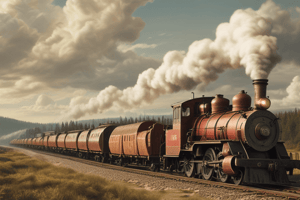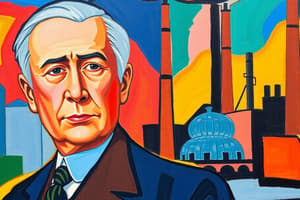Podcast
Questions and Answers
What natural resource provided the foundation for industrial development in Canada?
What natural resource provided the foundation for industrial development in Canada?
- Abundance of timber (correct)
- Coastal ports
- Fertile land
- Desert landscapes
Which government policy encouraged domestic production and investment in Canada?
Which government policy encouraged domestic production and investment in Canada?
- Free Trade Agreement
- Labor Union Law
- National Policy (correct)
- Immigration Act
What event marked a significant milestone in Canada's industrialization process?
What event marked a significant milestone in Canada's industrialization process?
- CPR Completion (correct)
- Confederation
- Depression of 1929
- World War I
Which industry emerged as a prominent industry in Quebec and Ontario?
Which industry emerged as a prominent industry in Quebec and Ontario?
What was a consequence of rapid urbanization in Canada during industrialization?
What was a consequence of rapid urbanization in Canada during industrialization?
Who championed the National Policy and played a key role in shaping Canada's industrial development?
Who championed the National Policy and played a key role in shaping Canada's industrial development?
What was a result of increased immigration from Europe, the United States, and Asia during industrialization?
What was a result of increased immigration from Europe, the United States, and Asia during industrialization?
What region experienced slower growth compared to Central Canada during industrialization?
What region experienced slower growth compared to Central Canada during industrialization?
Study Notes
Canada's Industrialization ( Late 19th - Early 20th Century)
Causes of Industrialization:
- Natural Resources: Abundance of natural resources, such as timber, minerals, and water power, provided the foundation for industrial development.
- Government Policies: National Policy (1879) imposed tariffs to protect Canadian industries, encouraging domestic production and investment.
- Immigration and Labor: Influx of immigrants and growth of urban centers provided a large workforce.
- Transportation Revolution: Construction of the Canadian Pacific Railway (1885) connected the country, facilitating the transportation of goods and people.
Key Industries:
- Manufacturing: Textiles, clothing, and food processing emerged as prominent industries, particularly in Quebec and Ontario.
- Resource Extraction: Mining (coal, iron, copper), logging, and fishing industries expanded, driven by demand for raw materials.
- Steel Production: Establishment of the steel industry in Hamilton, Ontario, and Sydney, Nova Scotia, fueled growth in rail production and shipbuilding.
Consequences of Industrialization:
- Urbanization: Rapid growth of cities, such as Montreal, Toronto, and Vancouver, led to the development of new social systems and infrastructure.
- Immigration and Diversity: Increased immigration from Europe, the United States, and Asia shaped Canada's demographics and cultural landscape.
- Regional Disparities: Industrialization exacerbated regional economic disparities, with the East and West coasts experiencing slower growth compared to Central Canada.
Key Figures and Events:
- Sir John A. Macdonald: Championed the National Policy and played a key role in shaping Canada's industrial development.
- ** CPR Completion (1885)**: The completion of the Canadian Pacific Railway marked a significant milestone in Canada's industrialization process.
- Winnipeg General Strike (1919): A major labor uprising highlighting workers' concerns about wages, working conditions, and labor rights.
Canada's Industrialization ( Late 19th - Early 20th Century)
Causes of Industrialization:
- Abundance of natural resources, including timber, minerals, and water power, laid the foundation for industrial development.
- The National Policy (1879) imposed tariffs to protect Canadian industries, encouraging domestic production and investment.
- Influx of immigrants and growth of urban centers provided a large workforce.
- The construction of the Canadian Pacific Railway (1885) connected the country, facilitating the transportation of goods and people.
Key Industries:
- Textiles, clothing, and food processing emerged as prominent industries in Quebec and Ontario.
- Mining (coal, iron, copper), logging, and fishing industries expanded, driven by demand for raw materials.
- The steel industry was established in Hamilton, Ontario, and Sydney, Nova Scotia, fueling growth in rail production and shipbuilding.
Consequences of Industrialization:
- Rapid growth of cities, such as Montreal, Toronto, and Vancouver, led to the development of new social systems and infrastructure.
- Increased immigration from Europe, the United States, and Asia shaped Canada's demographics and cultural landscape.
- Industrialization exacerbated regional economic disparities, with the East and West coasts experiencing slower growth compared to Central Canada.
Key Figures and Events:
- Sir John A. Macdonald championed the National Policy and played a key role in shaping Canada's industrial development.
- The completion of the Canadian Pacific Railway (1885) marked a significant milestone in Canada's industrialization process.
- The Winnipeg General Strike (1919) highlighted workers' concerns about wages, working conditions, and labor rights.
Studying That Suits You
Use AI to generate personalized quizzes and flashcards to suit your learning preferences.
Description
Explore the causes of industrialization in Canada during the late 19th and early 20th centuries, including natural resources, government policies, and immigration.




